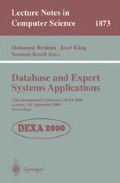Abstract
Histograms are used in most commercial database systems to estimate query result sizes and evaluation plan costs. They can also be used to optimize join algorithms. In this paper, we consider how to use histograms to improve the join processing in temporal databases. We define histograms for temporal data and a temporal join algorithm that makes use of this histogram information. The join algorithm is a temporal partition-join with dynamic buffer allocation. Histogram information is used to determine partition boundaries that maximize overall buffer usage. We compare the performance of this join algorithm to temporal join evaluation strategies that do not use histograms, such as a partition-based algorithm based on sampling and a partition-join using the Time Index, an index structure for temporal data. The results demonstrate that the temporal partition-join is substantially improved through the incorporation of histogram information, showing significantly better performance than the sampling-based algorithm and achieving equivalent performance to the Time Index join without requiring an index.
Access this chapter
Tax calculation will be finalised at checkout
Purchases are for personal use only
Preview
Unable to display preview. Download preview PDF.
References
H. Gunadhi and A. Segev. Query Processing Algorithms for Temporal Intersection Joins. In Proc. 7th ICDE, pages 336–344, April 1991.
E.P. Harris and K. Ramamohanarao. Join Algorithm Costs Revisited. The VLDB Journal, 5(l):64–84, 1996.
M. Kitsuregawa, H. Tanaka, and T. Motoka. Application of hash to database machine and its architecture. New Generation Computing, l(l):63–74, 1983.
T.Y. Leung and R. Muntz. Temporal query processing amd optimization in multiprocessor database machines. In Proc. of the 18th VLDB, pages 383–394, 1992.
V. Poosala, Y. Ioannidis, P. Haas, and E. Shekita. Improved Histograms for Selectivity Estimation of Range Predicates. In Proc, of ACM SIGMOD Conf., pages 294–305, June 1996.
Dieter Pfoser and Christian S. Jensen. Incremental join of time-oriented data. In Proc. of the 11th SSDBM, pages 232–243, 1999.
Viswanath Poosala. Histogram-based Estimation Techniques in Database Systems. PhD thesis, University of Wisconsin-Madison, 1997.
S. Rana and F. Fotouhi. Efficient Processing of Time-Joins in Temporal Data Bases. In Proc. 3rd Int. Symp. on DB Systems for Advanced Applications, pages 427–432, April 1993.
D. Son and R. Elmasri. Efficient Temporal Join Processing Using Time Index. In Proc. of the 8th SSDBM, pages 252–261, June 1996.
A. Segev and A. Shoshani. The Representation of a Temporal Data Model in the Relational Environment. In M. Rafanelli, J.C. Klensin, and P. Svensson, editors, LCNS, volume 339, pages 39–61. Springer-Verlag, 1988.
Inga Sitzmann and Peter Stuckey. Histogram-based Temporal Joins. Technical Report TR2000/7, Department of Computer Science and Software Engineering, The University of Melbourne, 2000.
M.D. Soo, R.T. Snodgrass, and C.S. Jensen. Efficient Evaluation of the Valid-Time Natural Join. In Proc. of the 10th ICDE, 1994.
Author information
Authors and Affiliations
Editor information
Editors and Affiliations
Rights and permissions
Copyright information
© 2000 Springer-Verlag Berlin Heidelberg
About this paper
Cite this paper
Sitzmann, I., Stuckey, P.J. (2000). Improving Temporal Joins Using Histograms. In: Ibrahim, M., Küng, J., Revell, N. (eds) Database and Expert Systems Applications. DEXA 2000. Lecture Notes in Computer Science, vol 1873. Springer, Berlin, Heidelberg. https://doi.org/10.1007/3-540-44469-6_46
Download citation
DOI: https://doi.org/10.1007/3-540-44469-6_46
Published:
Publisher Name: Springer, Berlin, Heidelberg
Print ISBN: 978-3-540-67978-3
Online ISBN: 978-3-540-44469-5
eBook Packages: Springer Book Archive

